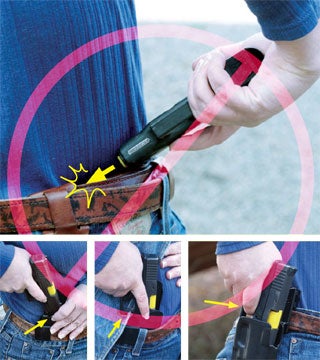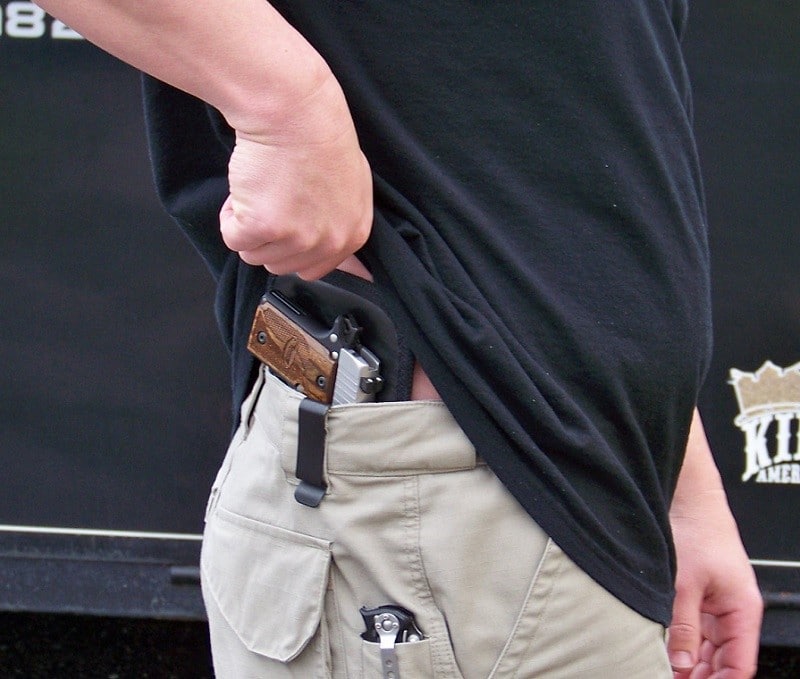“A 22-year-old Milwaukee man accidentally shot himself in the femoral artery around 11:00 PM Friday evening while attempting to reholster a pistol. Despite the best efforts of the local hospital trauma units, Timothy Phonisay did not survive his wounds.”
“The man was parked at the gas station at about 9:30 p.m. when he attempted to holster his .45. Immediately after the gun went off, he drove to a friend’s house in Lake Wildwood. When he got to the friends house, he took off his pants and saw that he had “shot himself in the penis and that the bullet exited out of his buttocks.” The spent round fell onto the floor.”
Lets check this video out.
This video is depicting how most people think when they reholster their weapon. :17 seconds in, we watch this guy jam his pistol into his holster at speed. :52 seconds in and he’s talking about just firing and then reholstering (don’t know why you would think that this is a viable tactic, but ok) but watch how he fumbles around even when looking at his holster. We can go through this and pick out more stuff, but lets just move on. ( fun fact, later on he flags himself while showing “proper” reholster technique)
When shooting instructors refer to the draw stroke they say it needs to be quick, smooth, and efficent, little love is given to the reholster. Reholstering your firearm is just as important as your draw, but instead of quick, you have to be slow and methodical. In a CCW scenario after you take out the bad guy(s) there is no need for quick action any more, the threat is gone, take your time. In competition you aren’t timed after your final shot, so why do people always seem to race the clock to get their gun away? With that said here is a little quick check list to hopefully keep you from shooting yourself on your reholster.
- Step 1: Breathe
- You have either shot something, someone, or have made ready to put your gun in your holster for the day. Slow your roll, this is the point where you could shoot yourself in alot of sensitive areas. Breathe
- Step 2: Is there a round in the chamber, cylinder, and is there a safety? Know your condition

checking the condition of the firearm - Look at your weapon, is there a safety? Is it on?
- If there is no safety, is there a round in the chamber? Brass check it.
- If you have a revolver, are you about to carry on a loaded chamber with an exposed hammer?
- Step 3: Clear your area
- Is there anything on your clothing that could get caught in the holster when you go to put your gun in it?

Floppy holster in trigger guard - Do you have on a jacket with toggles on the side which could get into the trigger guard?
- Is your leather holster folded over where a piece could get stuck into your trigger guard?
- Is there something on your person that could interfere with the safety on your gun?
- Is there anything on your clothing that could get caught in the holster when you go to put your gun in it?
- Step 4: Clear your body while you turn the gun into the holster
- Don’t flag yourself

How not to reholster - If you are carrying at your side or have some kind of shooting rig on, throw your hip out a little to make sure your aren’t about to have a negligent discharge into your foot, leg, or anywhere but the ground. Think of a light saber beam coming out of the barrel of the gun, don’t put any part of your body in this beam.
- Don’t flag yourself
- Step 5: It’s OK to look
- If you are loading up your gear for a day out, look where you are putting your firearm, you have all the time in the world to make this one part of your day a little safer. If you are appendix carrying move that holster where you are sure you won’t hit anything vital and that you visually see what you are doing.
- If you are a competition shooter, it’s totally OK to look at your holster while you are reholstering. You have just been running around, some conditions might have changed on your clothing/gear that could cause you to have an issue reholstering.
- Step 6: Slowly and deliberately slide your gun into its holster.
- Just slide it in.
- If you have to jam it in you are doing it wrong

- If your holster is that tight, then you need to loosen it.
- Watch what you’re doing, while you’re doing it.
- Step 7: Cover, Conceal, or Leave it alone till the next time don’t play with it until the next time you are about to shoot.
- Have a holster that stays in one place.
- The more you fiddle around with a loaded gun the more of a chance that it will go off.
That’s it, follow those steps and you run less of a chance at being that guy that shoots himself and winds up on the news. Granted you might not be the coolest kid at the range or at competition, but you can go home knowing that you are safe and that’s all that’s really important.
For more info on this topic check out this article from USCCA


